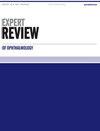小梁切除术失败后,胶原基质辅助丝裂霉素C开泡修补术的临床效果
IF 0.9
Q4 OPHTHALMOLOGY
引用次数: 0
摘要
摘要:小梁切除术(TB)联合丝裂霉素C (MMC)是青光眼手术中降低眼压和保护视野的主要方法,但手术结果往往受到导致眼压(IOP)峰值的膜外和结膜下纤维化的限制。研究设计和方法回顾性病例系列介绍了三期青光眼中心的7只眼睛,在由于过度纤维化导致结核病失败后,开放水泡针刺联合胶原基质植入和MMC。结果7例患者共7只眼。基线IOP为23.9(±7.4)mmHg,术后第1天显著下降至4.6 mmHg。术后1个月,所有眼保持非低张力IOP≥5。值得注意的是,有4只眼睛(57%)在没有胶原基质植入的情况下至少有1次不成功的开泡穿刺。术后随访(12.4±11.4个月)6只眼(86%)无青光眼药物治疗。所有病例均由一位经验丰富的青光眼专科医生(作者DL)进行手术。结论开放泡针和MMC联合胶原基质植入可改善小梁切除术失败后包裹性泡的IOP控制,特别是对先前不成功的泡修复患者。关键词:骨胶原青光眼胶原基质;修改;小梁切除术失败;作者贡献所有作者在研究设计和论文准备中都做出了重要贡献。J.C. Wong, J. Safran, S. Hallaj和D. Lee负责研究和数据采集的执行。J.C. Wong负责数据分析和解释。利益申报Lee获得了Allergan、Equinox、Glaukos、Mati、Nicox、Olleyes和Santan的研究支持,Glaukos的讲话费和Quidel Eye Health的咨询费。除了披露的内容外,作者与任何组织或实体没有其他相关关系或财务参与,这些组织或实体与稿件中讨论的主题或材料有经济利益或经济冲突。审稿人披露本文的每位审稿人没有相关的财务或其他关系需要披露。本文未获得资助。本文章由计算机程序翻译,如有差异,请以英文原文为准。
Clinical outcomes of collagen matrix as adjuvant to open bleb revision with mitomycin C following failed trabeculectomy
ABSTRACTIntroduction Trabeculectomy (TB) with mitomycin C (MMC) is a mainstay of glaucoma surgery for intraocular pressure reduction and visual field preservation, but surgical outcomes are often limited by episcleral and subconjunctival fibrosis leading to intraocular pressure (IOP) spikes.Research Design and Methods Retrospective case series presents seven eyes at a tertiary glaucoma center where open bleb needling was performed in combination with a collagen matrix implant and MMC following failed TB due to excessive fibrosis.Results Seven eyes of seven patients were included. Baseline IOP was 23.9 (±7.4) mmHg with a significant decrease on post-operative (post-op) day 1 to 4.6 mmHg. By post-op month 1, all eyes maintained a non-hypotonus IOP ≥ 5. Notably, four eyes (57%) had at least 1 unsuccessful open bleb needling without a collagen matrix implant prior. All eyes were complication-free by the latest visit without any complication-related visual decline, and six eyes (86%) were glaucoma medication-free at the most-recent post-op follow-up (12.4 ± 11.4 months). All cases were performed by one experienced glaucoma subspecialist (author DL).Conclusions Open bleb needling and MMC in combination with a collagen matrix implant may result in improved and sustained IOP control for encapsulated blebs following failed trabeculectomy, especially in those with prior unsuccessful bleb revisions.KEYWORDS: Ologenglaucomacollagen matrixbleb revisionfailed trabeculectomy Author contributionsAll authors made significant contributions to the research design and to the preparation of the manuscript. J.C. Wong, J. Safran, S. Hallaj and D. Lee were responsible for the execution of the research and data acquisition. J.C. Wong was responsible for the data analysis and interpretation.Declaration of interestD. Lee has received research support from Allergan, Equinox, Glaukos, Mati, Nicox, Olleyes, and Santan, lecture fees from Glaukos, and consulting fees from Quidel Eye Health. The authors have no other relevant affiliations or financial involvement with any organization or entity with a financial interest in or financial conflict with the subject matter or materials discussed in the manuscript apart from those disclosed.Reviewer disclosuresPeer reviewers on this manuscript have no relevant financial or other relationships to disclose.Additional informationFundingThis paper was not funded.
求助全文
通过发布文献求助,成功后即可免费获取论文全文。
去求助
来源期刊

Expert Review of Ophthalmology
Health Professions-Optometry
CiteScore
1.40
自引率
0.00%
发文量
39
期刊介绍:
The worldwide problem of visual impairment is set to increase, as we are seeing increased longevity in developed countries. This will produce a crisis in vision care unless concerted action is taken. The substantial value that ophthalmic interventions confer to patients with eye diseases has led to intense research efforts in this area in recent years, with corresponding improvements in treatment, ophthalmic instrumentation and surgical techniques. As a result, the future for ophthalmology holds great promise as further exciting and innovative developments unfold.
 求助内容:
求助内容: 应助结果提醒方式:
应助结果提醒方式:


